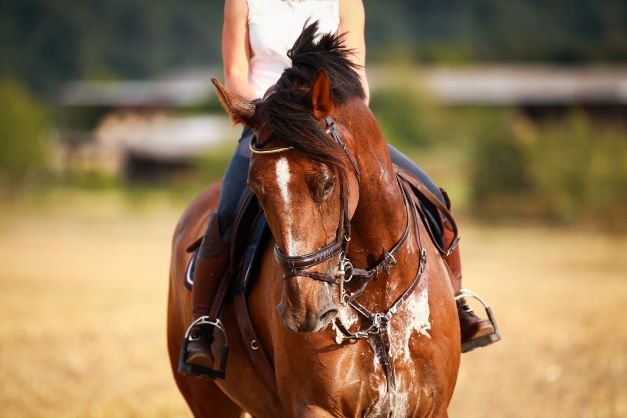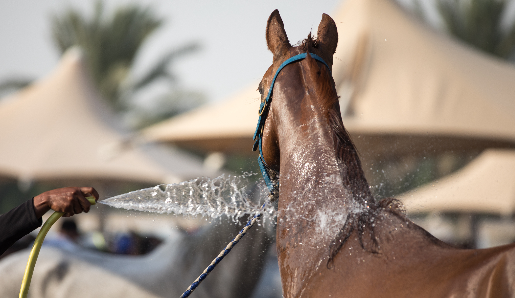Heat stress in horses doesn’t just happen with endurance horses, racehorses, polo ponies, and three-day eventers. When it’s hot and humid, horses being trailered, standing in a stall with no air moving, or turned out with no shade can be at risk for heat exhaustion and heat stroke. Learn to recognize heat stress in your horse and what to do about it. Then you will know to prevent it, when to use electrolyte supplements, and when to call the veterinarian.
What is heat stress in horses?
“Heat stress” is the medical term for when a horse overheats. Like humans, horses keep cool by sweating. When it’s hot and humid outside or they’re working hard, horses can get too hot. Mild overheating can quickly become more serious “heat exhaustion.” And even more concerning, “heat stroke” will require veterinary intervention if steps aren’t immediately taken to reduce the horse’s temperature.
 How do I know if my horse has heat stress?
How do I know if my horse has heat stress?
At first, a horse may just have a slightly increased body temperature, high heart rate, labored breathing with flared nostrils, and fatigue. If pressed on, the horse may develop signs and symptoms of heat exhaustion:
- Profuse sweat or thick, sticky sweat
- Temperature above 104°F (Normal: 99.5°F – 100.5°F)
- High heart rate, even after resting (Normal: 28-42 beats/minute)
- High respiratory rate, even after resting (Normal: 8-16 breaths/minute)
- Capillary refill time (CRT) more than three seconds
- Dry, sticky gums
- Reduced gut sounds
- Acting depressed or lethargic
- Tripping or stumbling
If a horse with these signs isn’t aggressively cooled to bring body temperature down, heat stroke may occur. Heat stroke is an emergency in which the horse’s internal temperature may be in the 105°F – 107°F range (or higher). Organs such as muscles, kidneys, liver, and intestines will begin to shut down.
Signs of heat stroke include:
- Complete lack of sweating
- No interest in the surroundings, or in eating or drinking
- Erratic behavior such as irritability, anxiety, head shaking, or random kicking
- Lack of coordination, disorientation, or weakness to the point of collapse
What should I do if my horse has heat stress?
At the first signs of heat stress in horses, stop exercise, untack the horse, and take him to a place with shade, a breeze, and cold water. Contact your veterinarian and explain what is going on. Let them decide if they need to come out to provide emergency care. If caught early enough, aggressive cooling may be all that is needed. Take the horse’s vital signs (temperature, pulse and respiration) every 10 minutes. Share this information with your veterinarian so that if your horse isn’t showing signs of recovering, they can come out and provide first aid.
Apply ice-cold water all over your horse’s body. Continuously hosing without taking a break to scrape is the ideal method. Contrary to what many think, this will not cause your horse to develop cramps or tying up. While hosing, allow your horse to drink up to a gallon at a time of fresh, cool or cold water. Research shows that letting a hot horse drink water after exercise is one of the best things you can do. This may save his life, not put it at risk.
How do I prevent heat stress in my horse?
The temperature plus humidity is commonly used as a guide for whether it’s too hot to ride. When the total is above 150, experts recommend using caution when exercising horses. When the total is above 180, extreme caution should be used, which may mean not working the horse that day. The combination of exercise and hot, humid weather is likely to overwhelm the horse’s ability to keep itself cool.
Unfortunately, in some parts of the country, using just temperature plus humidity as a guide may rule out riding on many summer days. In this case, take into account whether the horse is used to the heat and humidity, how fit they are, and the horse’s age. Senior horses tend to have a harder time with extreme heat and humidity.
Here are some additional tips for safely getting through warmer weather with your horse:
- Keep clean, fresh, cool water available at all times
- Provide shade when horses are outside in direct sun
- Use agriculture-rated stall fans to keep air moving when horses are inside
- Exercise and trailer horses during the coolest parts of the day
- Plan shorter, less intense workouts with more breaks
- Hose horses off after exercise, even if they are just sweaty from standing in the heat
- Keep track of the horse’s vitals whenever there’s a chance of overheating
Is there a role for supplements in heat stress?
Since sweating is your horse’s primary means for staying cool, it’s important the system functions well. Horses need two things to sweat efficiently:
- Unlimited access to water to replenish lost fluid (horses can produce one gallon of sweat every 15 minutes, which is 4 gallons an hour!)
- Electrolytes to replace lost minerals
Sweat is a mixture of sodium (Na), chloride (Cl), and potassium (K), with a small amount of calcium and a few other minerals. Most experts advise choosing an electrolyte supplement without added sugar, since the horse doesn’t need it. Whenever a horse is sweating – whether from hot temperatures, exercise, trailering, etc. – they should be supplemented with electrolytes.
In addition, a good way to help horses stay hydrated is to top-dress their feed with salt (sodium and chloride) since sodium is the main trigger for thirst and the horse’s natural diet usually doesn’t provide their daily requirement. Providing an ounce (2 Tbsp.) of salt every day, all year round, will encourage horses to drink in all temperatures and conditions, hot or cold. When it’s the season for sweating, horses should be supplemented with both an electrolyte and salt.
Summary
Heat stress in horses can be a serious situation if not recognized and treated early. Anyone exercising or caring for a horse should know what to watch for, how to take vital signs, and when to call the veterinarian. Modern methods of cooling off a hot horse, how to prevent overheating in the first place, and supplementing the sweating and dehydrated horse are also important to learn.


